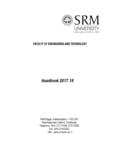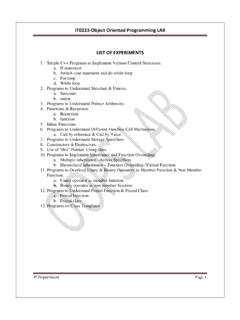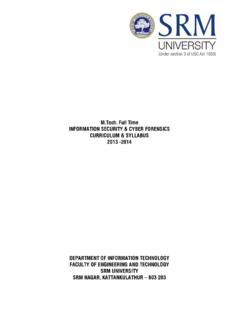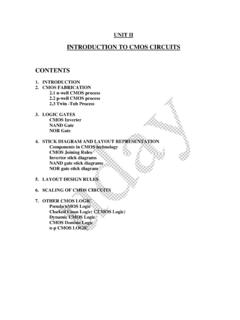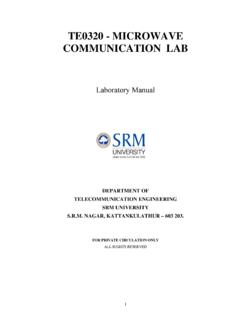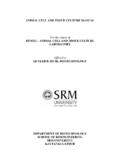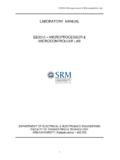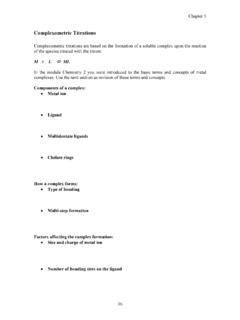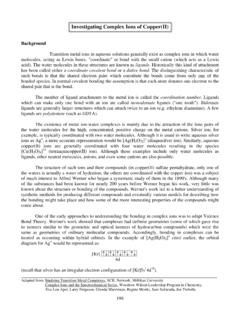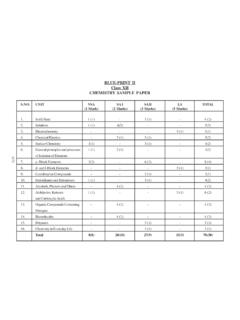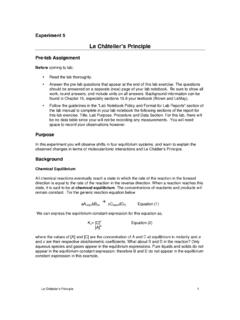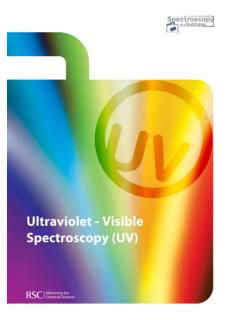Transcription of Complexometric titration - SRM Institute of Science and ...
1 Complexometric titration Complexometric titration (sometimes chelatometry) is a form of volumetric analysis in which the formation of a colored complex is used to indicate the end point of a titration . Complexometric titrations are particularly useful for the determination of a mixture of different metal ions in solution. An indicator capable of producing an unambiguous color change is usually used to detect the end-point of the titration . Reactions for Complexometric titration In theory, any complexation reaction can be used as a volumetric technique provided that: 1.
2 The reaction reaches equilibrium rapidly after each portion of titrant is added. 2. interfering situations do not arise. For instance, the stepwise formation of several different complexes of the metal ion with the titrant, resulting in the presence of more than one complex in solution during the titration process. 3. a Complexometric indicator capable of locating equivalence point with fair accuracy is available. In practice, the use of EDTA as a titrant is well established complex titration with EDTA EDTA, ethylenediaminetetraacetic acid, has four carboxyl groups and two amine groups that can act as electron pair donors, or Lewis bases.
3 The ability of EDTA to potentially donate its six lone pairs of electrons for the formation of coordinate covalent bonds to metal cations makes EDTA a hexadentate ligand. However, in practice EDTA is usually only partially ionized, and thus forms fewer than six coordinate covalent bonds with metal cations. Disodium EDTA is commonly used to standardize aqueous solutions of transition metal cations. Disodium EDTA (often written as Na2H2Y) only forms four coordinate covalent bonds to metal cations at pH values 12. In this pH range, the amine groups remain protonated and thus unable to donate electrons to the formation of coordinate covalent bonds.
4 Note that the shorthand form Na4-xHxY can be used to represent any species of EDTA, with x designating the number of acidic protons bonded to the EDTA molecule. EDTA forms an octahedral complex with most 2+ metal cations, M2+, in aqueous solution. The main reason that EDTA is used so extensively in the standardization of metal cation solutions is that the formation constant for most metal cation-EDTA complexes is very high, meaning that the equilibrium for the reaction: M2+ + H4Y MH2Y + 2H+ lies far to the right.
5 Carrying out the reaction in a basic buffer solution removes H+ as it is formed, which also favors the formation of the EDTA-metal cation complex reaction product. For most purposes it can be considered that the formation of the metal cation-EDTA complex goes to completion, and this is chiefly why EDTA is used in titrations / standardizations of this type. Indicators To carry out metal cation titrations using EDTA, it is almost always necessary to use a Complexometric indicator to determine when the end point has been reached.
6 Common indicators are organic dyes such as Fast Sulphon Black, Eriochrome Black T. Color change shows that the indicator has been displaced (usually by EDTA) from the metal cations in solution when the endpoint has been reached. Thus, the free indicator (rather than the metal complex ) serves as the endpoint indicator. TlTRATlON OF MIXTURES, SELECTIVITY, MASKING AND DEMASKING AGENTS EDTA is a very unselective reagent because it complexes with numerousdoubly, triply and quadruply charged cations. When a solution containingtwo cations which complex with EDTA is titrated without the addition of a complex -forming indicator, and if a titration error of per cent ispermissible, then the ratio of the stability constants of the EDTA complexesof the two metals M and N must be such that KM/KN > 106 if N is not to interfere with the titration of M.
7 Strictly, of course, the constants KM and KN considered in the above expression should be the apparent stability constants of the complexes. If complex -forming indicators are used, then for a similar titration error KM/KN > following procedures will help to increase the selectivity : (a) Suitable control of the pH of the solution. This, of course, makes use of the different stabilities of metal-EDTA complexes. Thus bismuth and thorium can be titrated in an acidicsolution (pH = 2) with xylenol orange or methylthymol blue as indicatorand most divalent cations do not mixture of bismuth and lead ions can be successfully titrated by firsttitrating the bismuth at pH 2 with xylenol orange as indicator, and thenadding hexamine to raise the pH to about 5, and titrating the lead.
8 (b) Use of masking agents. Masking may be defined as the process in which a substance, withoutphysical separation of it or its reaction products, is so transformed that it does not enter into a particular reaction. Demasking is the process inwhich the masked substance regains its ability to enter into a particular reaction. By the use of masking agents, some of the cations in a mixture can often be 'masked' so that they can no longer react with EDTA or with the indicator. An effective masking agent is thecyanide ion; this forms stablecyanide complexes with the cations of Cd, Zn, Hg(II), Cu, Co, Ni, Ag, and the platinum metals, but not with the alkaline earths, manganese, and lead It is therefore possible to determine cations such as Ca2+, Mg2+, Pb2+, and Mn2+ in the presence of the above-mentioned metals by masking with an excess of potassium or sodium cyanide.
9 A small amount of iron may be masked by cyanide if it is first reduced to the iron(II) state by the addition of ascorbic acid. Titanium(IV), iron(III), and aluminium can be masked with triethanolamine; mercury with iodide ions; and aluminium, iron(III), titanium(IV), and tin(II) with ammonium fluoride (the cations of the alkaline-earth metals yield slightly soluble fluorides). Sometimes the metal may be transformed into a different oxidation state: thus copper(II) may be reduced in acid solution by hydroxylamine or ascorbic acid.
10 After rendering ammoniacal, nickel or cobalt can be titrated using, for example, murexide as indicator without interference from the copper, which is now present as Cu(I). Iron(III) can often be similarly masked by reduction with ascorbic acid. (c) Selective demasking. The cyanide complexes of zinc and cadmium may be demasked with formaldehyde-acetic acid solution or, better, with chloral hydrate : The use of masking and selective demasking agents permits the successive titration of many metals. Thus a solution containing Mg, Zn, and Cu can be titrated as follows: 1.
